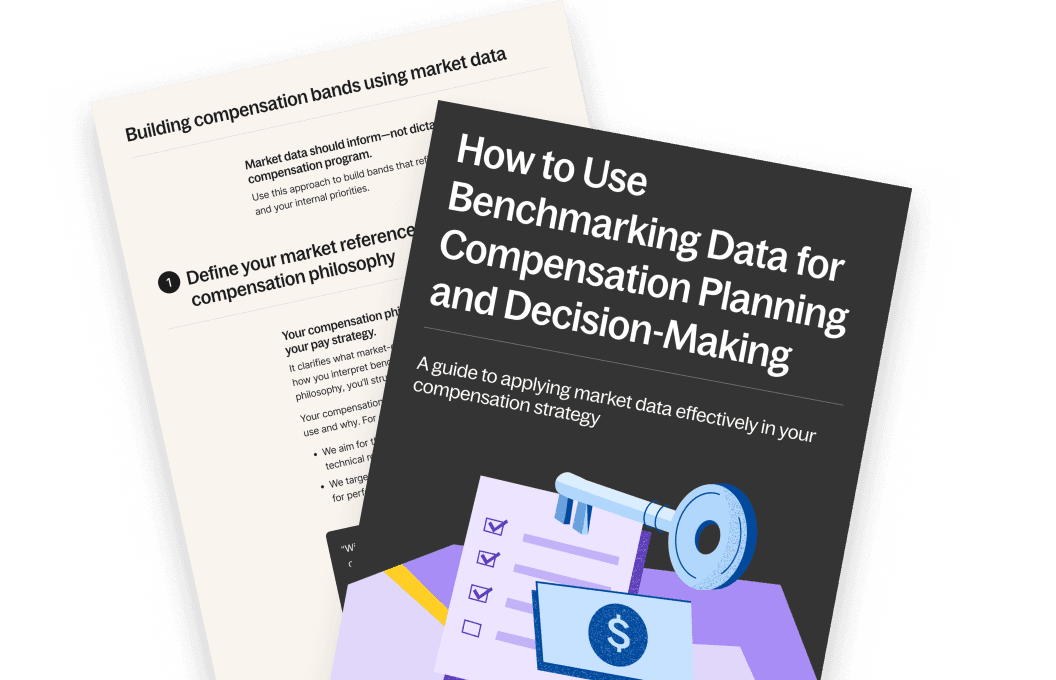Guide
How to Use Compensation Benchmarking Data for Planning and Decision-Making
Global HR

Get the resource for free
Compensation planning isn’t just spreadsheets and market data. It’s a balancing act between fairness, competitiveness, and compliance. But the hardest part? Making sense of the numbers.
With expectations shifting fast and pay transparency laws tightening globally, relying on guesswork (or outdated surveys) puts your hiring, retention, and equity at risk. That’s why forward-thinking People teams use benchmarking data to set pay ranges and justify every comp decision with confidence.
Use this guide as a reference at every stage of compensation planning, from choosing data sources to training managers. Ensure your compensation decisions are not only data-driven but also aligned, equitable, and built to scale with your company.
Guide overview
How to Use Compensation Benchmarking Data for Planning and Decision-Making is your go-to resource for navigating the most misunderstood (but critical) step in comp planning.
Inside, you’ll get:
- A plain English glossary of compensation and benchmarking terms
- A breakdown of how benchmarking datasets are built (and what to watch out for)
- Step-by-step guidance on applying benchmarking data to your pay bands, offers, merit cycles, and internal equity reviews
- Common pitfalls and how to avoid them
- A snapshot of how Deel helps you stay compliant while managing compensation globally
Skim the glossary to align your team on the lingo, then focus on the chapters that match your current comp challenges, whether that’s setting salary ranges, fixing pay gaps, or planning your next merit cycle.
Bonus tip: Share it with your executives or finance partners. The guide is written to help you get aligned quickly.
This guide is perfect for
- People Ops leaders at growing companies
- HR managers tasked with global compensation
- Finance and exec teams looking to align compensation with strategy
- Anyone building or refreshing a compensation framework
Whether hiring in one country or across five continents, this guide helps you make smarter, fairer, and faster pay decisions. Download this free guide and bring clarity to your compensation planning.
FAQs
What does benchmarking mean in compensation?
Compensation benchmarking is the process of comparing your company’s pay for specific roles to market rates gathered from salary surveys, industry standards, and other trusted data sources. The goal is to understand whether your internal salaries align with what similar roles earn elsewhere based on job title, company size, and sometimes location.
It’s a critical part of compensation planning and helps ensure you offer a competitive salary that can attract and retain talent while also supporting pay equity across your organization.
What does it mean to benchmark a position?
Benchmarking a position means identifying the right external job match and comparing your current pay for that role to market rates. It’s not just about salary; it also includes total compensation, such as bonuses and benefits, drawn from survey data. Benchmarking helps ensure you’re offering a competitive salary that fits the role’s value and complexity in today’s market.
Is compensation benchmarking legal?
Yes, compensation benchmarking is legal as long as you use aggregated, anonymized survey data from reputable sources. However, you need to be careful when sharing or collecting competitor pay data directly, as this could raise antitrust concerns. Stick to established compensation surveys and avoid any one-to-one data exchanges.
Who does compensation benchmarking?
Usually, HR or compensation specialists lead the benchmarking process. In smaller companies, it might be the solo HR manager, while larger firms may have a dedicated comp & benefits team. Sometimes finance or external consultants help, especially during broader compensation planning or when making major structural pay changes.
What is the first step in compensation benchmarking?
The first step in compensation benchmarking is to clearly define the job titles and roles you want to benchmark. That means creating accurate, updated job descriptions and identifying a good job match in the market.
You’ll also need to decide on comparison criteria like company size, industry, and location—all of which affect market rates. Without this foundation, the survey data you gather won’t be reliable for your compensation planning.
How do you benchmark salaries?
To benchmark salaries, you start by selecting trusted compensation data sources, often through salary surveys or a compensation survey provider. Then, you compare your internal salary ranges to average salaries and market trends for similar job titles in similar companies.
Adjustments are made based on factors like experience level, region, and company type. The result informs your salary ranges and helps align your compensation strategy with external expectations.
What source do most employers use to benchmark compensation?
Most employers rely on third-party salary and compensation survey providers like Mercer or Radford. Some also use government sources or aggregated market trends from platforms like LinkedIn or Glassdoor, though those are less precise.
For more accuracy, companies often pair external data with their own internal salary records and peer benchmarks.